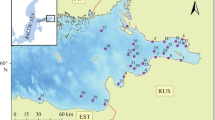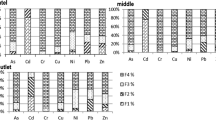Abstract
The article considers biogeochemical features of cadmium as one of the most dangerous elements. Data on its concentrations in waters of small lakes in the European Russia (from the tundra to deserts) and large river systems (Volga, Severnaya Dvina, Pechora) are given. It is shown that, despite the relatively low concentrations of the element in waters, its enrichment factor is hundreds and thousands of units, especially in the northern regions and regions subjected to the influence of non-ferrous metallurgy. Data are presented on the bioaccumulation of cadmium within fish body systems, which is determined by the concentration of the element in waters, as well as by the water pH and the calcium content. It is proved that the highest Cd concentrations are accumulated in kidneys and liver of whitefish and salmon, causing pathological disturbances. Data are reported on the accumulation of cadmium in kidneys and liver of human population of the industrially developed Northern region under impacts of copper–nickel smelters. The similarity in tendencies of the Cd accumulation and pathological disturbances in fish and the population consuming water from contaminated sources makes it possible to recommend fish as a bioindicator of the environmental pollution by cadmium.
Similar content being viewed by others
References
Acidification of Mountain Lakes: Palaeolimnology and Ecology. AL:PE Report 1/1995, 130 p.
A List of Fishery Norms: Maximum Permissible Concentrations (MPC) and Approximate Safe.
S. M. Adams M. G. Ryon, (1994). A comparison of health assessment approaches for evaluating the effects of contaminant- related stress on fish populations. Aquatic Ecosystem. (3), 15–25.
AMAP Assessment 2002: Heavy Metals in the Arctic. Arctic Monitoring and Assessment Programme (AMAP), (Oslo, 2005). (first published as electronic document in 2004)
M. J. Attrill and M. H. Depledge, “Community and population indicators of ecosystem health: targeting links between levels of biological organization,” Aquat Toxicol. 38, 183–197 (1997).
M. Bennet-Chambers, P. Davies, and B. Knott, “Cadmium in aquatic ecosystems in Western Australia: A legacy of nutrient-deficient soils,” J. Environ. Manage 57, 283–295 (1999).
G. W. Bryan, “Heavy metal contamination in the sea,” in Marine Pollution, Ed. by R. Johnston (Academic Press, London–New York–San Francisco, 1979), pp. 185–302.
M. M. Brzoska J. Moniuszko-Jakoniuk, “Interaction between cadmium and zinc in the organism,” Food Chem. Toxicol. 39, 967–980 (2001).
Cadmium in Ferstilizers. Risks to Human Health and the Environment. Ministry of Agriculture and Forestry. Publications of the Ministry of Agriculture and Forestry, No. 9, (1997).
Canadian Water Quality Guidelines (Canadian Council of Ministry of Environment, Ottawa, 1994).
K. J. Cash, “Assessing and monitoring aquatic ecosystem health–approaches using individual, population, and community/ecosystem measurements,” Northern River Basins Study Project Report. No. 45 (1995).
C. Conto Cinier, M. Petit-Ramel, R. Faure, and D. Garin, “Cadmium bioaccumulation in carp (Cyprino carpio) tissues during long-term exposure: analysis by Inductively Coupled Plasma-Mass Spectrometry,” Ecotoxicol. Envirn. Saf. 38, 137–143 (1997).
T. Crommentuijn, D. Sijm, J. Bruijn, M. Hoop, K. Leeuwen, and E. Plassche, “Maximum permissible and negligible concentrations for metals and metalloids in the Netherlands, taking into account background concentrations,” J. Environ. Manage 60, 121–143 (2000).
J. T. Cullen, and M. T. Maldonado, “Biogeochemistry of cadmium and its release to the environment, in Cadmium: From Toxicity to Essentiality, Ed. by A. Sigel, H. Sigel, and R. Sigel (Springer, 2013), pp. 31–62.
V. V. Ermakov, “Cadmium in the polimetallic biogeochemical provinces and health animal problem,” in Cadmium in the Environment: Ecological and Analytical Problems (Naukove, Warshava, 2000), pp. 11–23.
N. A. Gashkina, Y. G. Tatsii, V. N. Udachin, and P. G. Aminov, “Biogeochemical indication of environmental contamination: a case study of a large copper smelter,” Geochem. Int. 53(3), 253–264 (2015).
A. G. Heath, Water Pollution and Fish Physiology (Lewis Publishers, London, 2002).
GOST 31861–2012. Water. General Requirements to Sampling (Standartinform, Moscow, 2013).
IARC. Cadmium and Cadmium Compounds, Monographs on the Evaluation of the Carcinogenic Risk of Chemicals to Humans 58, 119–237 (1993).
ICME (International Council on Metals and the Environment). Persistence, Bioaccumulation and Toxicity of Metals and Metal Compounds. (Parametrix, Washington, 1995).
IPCS, International Programme on Chemical Safety: Cd. Environmental Health Criteria, (World Health Organization, Geneva, 1992), pp. 134–142.
K. Johansson, E. Bringmark, L. Lindevall, and A. Wilanders, “Effects of acidification on the concentration metals in running water in Sweden,” Water, Air, Soil Pollut. 85, 779–784 (1995).
Levels of Influence (ASLI) of Toxic matters for Water of Water Objects of Fishery Significance (VNIRO, Moscow, 1999) [in Russian].
Q. Li, M. Nishijo, H. Nakagawa, Y. Morikawa, M. Sakurai, K. Nakamura, T. Kido, K. Nogawa, and M. Dai, “Relationship between urinary cadmium and mortality in habitants of a cadmium-polluted area: a 22-year follow- up study in Japan,” Chinese Medical J. 124 (21), 3504–3509 (2011).
A. R. Linde, S. Sanchez-Galan, P. Valles-Mota, and E. Garcia-Vasquez, “Metallothionein as bioindicator of freshwater metal pollution: European eel and brown trout,” Ecotoxicol. Environ. Saf. 49, 60–63 (2001).
I. A. Linnik and B. I. Nabivanets, Metal Migration Speciation in Fresh Surface Waters (Gidrometeoizdat, Leningrad, 1986) [in Russian].
G. Lithner, Quality Criteria for Lakes and Watercourses. Background Report 2–Metals. Swedish EPA Report 3628 (1989).
MAFF. Fishery and Food. Aquatic Environment Monitoring Report of Ministry of Agriculture, (Directorate of Fisheries Research, Lowestoft, 1995).
J. C. McGeer, C. Szebedinsky, D. G. McDonald, and C. M. Wood, “Effects of chronic sublethal exposure to water-borne Cu, Cd or Zn in rainbow trout 2: tissue specific metal accumulation,” Aquat. Toxicol. 50, 245–256 (2000).
V. Megorsky, “The Influence Industrial contamination on quality of drinking water and health of the population in condition Arctic,” Collection Article to Science Congress Environment and Human Health (Saint-Petersburg, 2003), pp. 32–33.
T. I. Moiseenko and N. A. Gashkina, “The distribution of trace elements in surface continental waters and the character of their migration in water,” Water Res. 34 (4), 423–437 (2007).
T. I. Moiseenko, A. A. Voinov, V. V. Megorsky, N. A. Gashkina, L. P. Kudriavtseva, O. I. Vandish, A. N. Sharov, Yu. Sharova, and I. N. Koroleva, “Ecosystem and human health assessment to define environmental management strategies: the case of long-term human impacts on an Arctic lake,” Sci. Total Environ. 369, 1–20 (2006).
T. I. Moiseenko, V. V. Megorskii, N. A. Gashkina, and L. P. Kudryavtseva, “Water pollution effect on population health in an industrial northern region,” Water Res. 37 (2), 194–203 (2010).
T. I. Moiseenko, N. A. Gashkina, and M. I. Dinu, “Enrichment of surface water by elements: effects of air pollution, acidification and eutrophication,” Environ. Process. 3, 39–58 (2016).
J. W. Moore, and S. Ramamoorthy, Heavy Metals in Natural Waters. Applied Monitoring and Impact Assessment (Springer-Verlag, New York, 1984).
M. Nishijo, H. Hakagawa, and T. Kido, “Environmental cadmium exposure and hypertension and cardiovascular risk,” in Metals in Biology and Medicine, Ed. by J. A. John (Libbey Eurotext, Paris, 2000), pp. 365–367.
S. A. Norton, P. J. Dillon, and R. D. Evans, “The history of atmospheric deposition of Cd, Hg and Pb in North America: Evidence from lake and peat bog sediments,” Sources, Deposition and Capony Interactions. Vol. lll. Acidic Precipitation, Ed. by S. E. Lindberg (Springer-Verlag, New York, 1990), pp. 73–101.
J. O. Nriagu and J. M. Pacyna, “Quantitative assessment of worldwide contamination of air, water and soils by trace metals,” Nature 333, 134–139 (1988).
A. A. Perevoznikov, and E. A. Bogdanova, Heavy Metals in Fresh Aqueous Ecosystems (GosNIORKh, St. Petersburg, 1999) [in Russian].
D. J. H. Phillips, “The chemistries and environmental fates of trace metals and organochlorines in aquatic ecosystems,” Mar. Pollut. Bull. 31, 193–200 (1995).
E. L. Porter, R. A. Kent, D. E. Anderson, K. A. Keenleyside, D. Milne, P. Cureton, S. L. Smith, and K. G. Drouillard, “Development of proposed Canadian Environment Quality Guidelines for cadmium,” J. Geochem. Explor. 52, 205–219 (1995).
B. A. Revich, S. L. Fvaliani, and G. I. Tikhonova, Environment and Health of Population: Regional Ecological Politics (TsEPR, Moscow, 2003) [in Russian].
M. Sakamoto, A. Yasutake, J. Domingo, H. M. Chan, M. Kubota, and K. Murata, “Relationships between trace elements concentration in chorionic tissue of placenta and umbilical cord tissue: Potential use as indicators for prenatal exposure,” Environ. Int. 60, 106–111 (2013).
S. Satarug, J. R. Baker, P. E. Reilly, M. R. Moore, and D. J. Williams, Cadmium levels in the lung, liver, kidney cortex and urine sample from Australia without occupational exposure to metals,” Arch. Environ. Health 57, 69–77 (2002).
S. Satarug, J. R. Baker, S. Urbenjapol, M. Haswell-Elkins, P. E. B. Reilly, D. J. Williams, and R. Moore, “A global perspective on cadmium pollution and toxicity in nonoccupationally exposed population,” Toxicol. Lett. 13, 65–83 (2003).
S. Satarug, S. H. Garrett, M. A. Sens, and D. A. Sens, “Cadmium, environmental exposure, and health outcomes,” Environ. Health Persp. 118, 82–190 (2010).
B. L. Skjelkvale, T. Andersen, E. Fjeld, J. Mannio, A. Wilander, K. Johansson, J. P. Jensen, T. Moiseenko, J. Vuorenmaa, and O. Royseth, “Heavy metals in nordic lakes; concentrations, geographical patterns and relation to critical limits,” AMBIO 30 (1), 2–10 (2002).
K. A. Sloman, G. R. Scott, Z. Diao, C. Rouleau, C. M. Wood, and D. G. McDonald, “Cadmium affects the social behavior rainbow trout, Onconrhynchus mykiss,” Aquat. toxicol. 65, 171–185 (2003).
D. J. Spry and J. G. Wiener, “Metal Bioavailability and toxicity to fish in low-alkalinity lakes: a critical review,” Environ. Pollut. 71, 243–304 (1991).
Toxic Chemical Matters. Inorganic Compounds of Groups I–IV (Khimiya, Leningrad, 1988) [in Russian].
A. Voinov, L. Bromley, E. Kirk, T. I. Moiseenko, and V. V. Mogorsky, “Understanding human and ecosystem dynamics in the Kola Arctic: a participatory integrated study,” ARCTIC 57 (4), 375–388 (2004).
C. M. Wood, “Toxic responses of the gill,” in Target Organ Toxicity in Marine and Freshwater Teleosts, Ed. by D. Schlenk and W. H. Benson (Taylor and Francis, London, 2001).
A. V. Zhulidov, Physicochemical and chemical state of metals in natural waters: toxicity for fresh-water organisms, in Ecological Normalization and Modeling of Anthropogenic Influence on Water Ecosystems (Gidrometeoizdat, Leningrad, 1988), Vol. 1, pp. 78–82 [in Russian].
Author information
Authors and Affiliations
Corresponding author
Additional information
Original Russian Text © T.I. Moiseenko, N.A. Gashkina, 2018, published in Geokhimiya, 2018, No. 8, pp. 759–773.
Rights and permissions
About this article
Cite this article
Moiseenko, T.I., Gashkina, N.A. Biogeochemistry of Cadmium: Anthropogenic Dispersion, Bioaccumulation, and Ecotoxicity. Geochem. Int. 56, 798–811 (2018). https://doi.org/10.1134/S0016702918080062
Received:
Accepted:
Published:
Issue Date:
DOI: https://doi.org/10.1134/S0016702918080062




